5 Proven Ways to Uncover Your Competitors’ Keywords in 2025
Source : 5 Proven Ways to Uncover Your Competitors’ Keywords in 2025
Published On : September 09, 2025 at 10:32PM
By : Ankit Singla
Competitor keyword research is perhaps the most valuable SEO strategy I’ve learned in over 14 years.
Not only does it help you find surefire keywords that generate positive results, it also gives you an opportunity to outrank and beat your competitors in their own game — stealing their traffic and positioning yourself as the more dominant brand.
In this post, I rounded up my go-to competitor keyword research strategies using Semrush SEO Toolkit.
Before anything else, remember that these strategies can be done with free or paid alternatives to Semrush. But for the sake of this guide, we’re demonstrating steps to strategies based on how I do it, and that’s with the Semrush SEO Toolkit.
Let’s get started.
Conducting Competitor Keyword Research with Semrush SEO Toolkit
Here’s a quick rundown of the exact ways I use SEO Toolkit to find profitable keywords that drive growth and profits for my competitors:
1. Checking Top Keywords Through Organic Research
Whenever I need quick keyword ideas from competitors, the first thing I do is inspect their top keywords using the Organic Research tool.
From the Semrush dashboard, click the ‘SEO’ menu and select ‘Organic Research’ under “Competitive Research.”
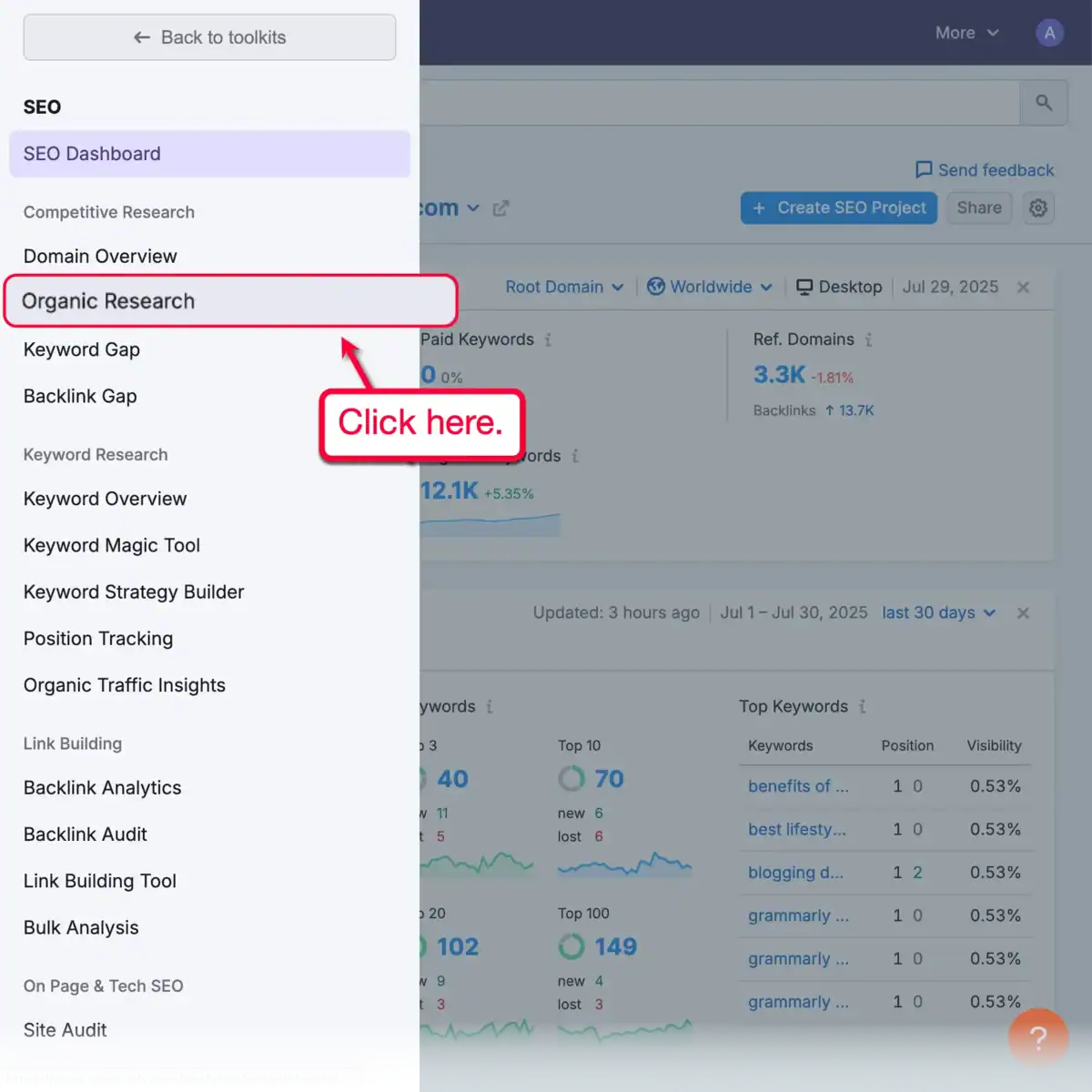
In the Organic Research form, enter your competitor’s URL, lock in your country, and click ‘Search.’
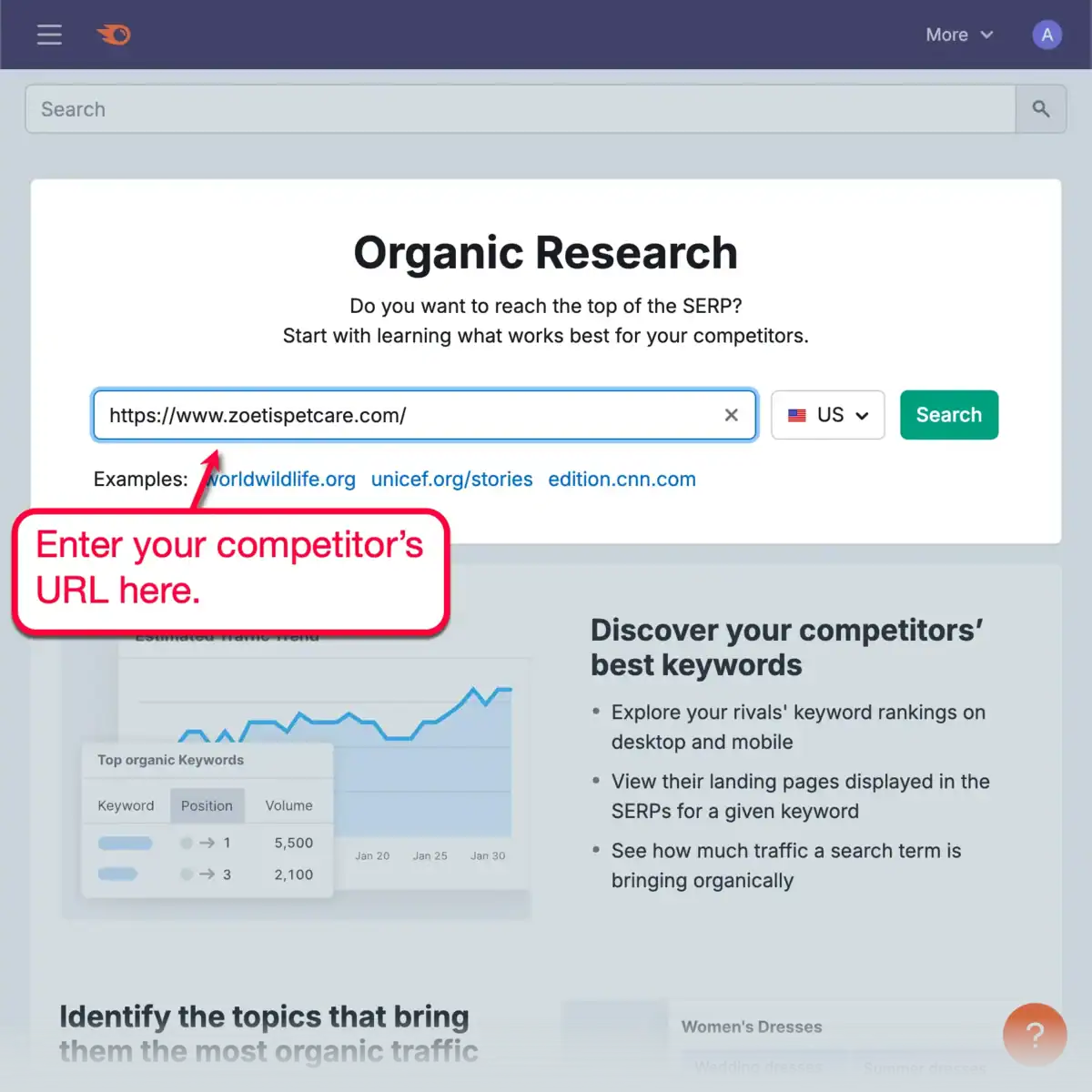
On the Organic Research report page, scroll down to the “Top Keywords” section.
You should find a list of your competitor’s top five keywords between organic search results and rich snippets (also called SERP features). Don’t get discouraged if this is filled with branded keywords — that’s just at the surface.

Click the ‘View all’ button for a more comprehensive list of your competitor’s keywords. This will take you to a longer list of keywords with crucial metrics, like average search volume, Keyword Difficulty (KD) rating, and the actual traffic that goes to competitors.

Take note that the organic research report will have limited data if you’re using a free account. If you like to evaluate Semrush SEO Toolkit’s full potential, create a free trial here and follow along as we try the strategies together.
Viewing the report is a great way to find competitor keywords with a lot of traffic potential.
Just remember that the Organic Research tool can also check an exact URL for keywords — not just swipe the entire keyword portfolio of an entire business.
This brings us to my next favorite strategy.
2. Analyzing Competitor Landing Pages
Analyzing the keywords of a competitor’s landing page is guaranteed to help you get profitable SEO results.
After all, you’re assured that you’ll find keywords meant to pull visitors who are more likely to make a purchase.
Still using the Organic Research tool, just enter the exact URL of the page you want to analyze. Or, if you’re viewing the organic keywords report for the whole site, just click on the specific link under the “URL” column.

This will take you to a fresh Organic Research report with a narrower (and usually more profitable) list of organic keyword ideas.

To make sure you’re finding keywords that attract customers with purchase intent, click ‘View all’ and use the intent filter.
Basically, you need ot make sure you’re scraping competitor keywords with “commercial” or “transactional” intent.

This filter essentially makes sure you’re only looking at keywords that customers use when they’re ready to buy or commit to a transaction.

Tip: While you’re going out analyzing competitor pages, make sure to include their top-performing content. You’ll find the URLs you need under the “Top Pages” section of the organic research report.

3. Tracking Competitors’ Position Changes
Here’s a neat trick that plenty of businesses often miss.
When analyzing competitor keywords with Semrush, I look at their “new” and “lost” keywords to learn two things: their current SEO priorities and keywords they’re neglecting.
Switch to the ‘Position Changes’ tab to view this information.

To check your competitor’s new and lost keywords, scroll down to the keywords table and look at the “Diff.” column.
You should find keywords tagged as “New” and “Lost” — or, positive and negative values that denote how their rankings have moved.

Tracking new keywords will help you stay ahead of trends and seasonal keywords that your competitors are prioritizing.
Personally, I check my competitors’ position changes regularly to keep my strategy up-to-date with the latest trends. In some cases, I found keywords they were slipping on — perfect for being assimilated into my strategy and outranking competitors.
4. Spying on Competitor Backlink Anchor Texts
This next strategy unveils not just the keywords other businesses rank for, but also the keywords they’re actually targeting.
Remember, link building is the primary method of ranking for online search keywords — boosting your online presence and generating referral traffic at the same time. By looking at the anchor texts they’re using, you’ll get a better idea of which keywords sit at the top of their priorities.
For this, you need to fire up the backlink analytics tool under the “Link Building” section of the SEO menu.

Next, enter your competitor’s URL and click ‘Analyze.’
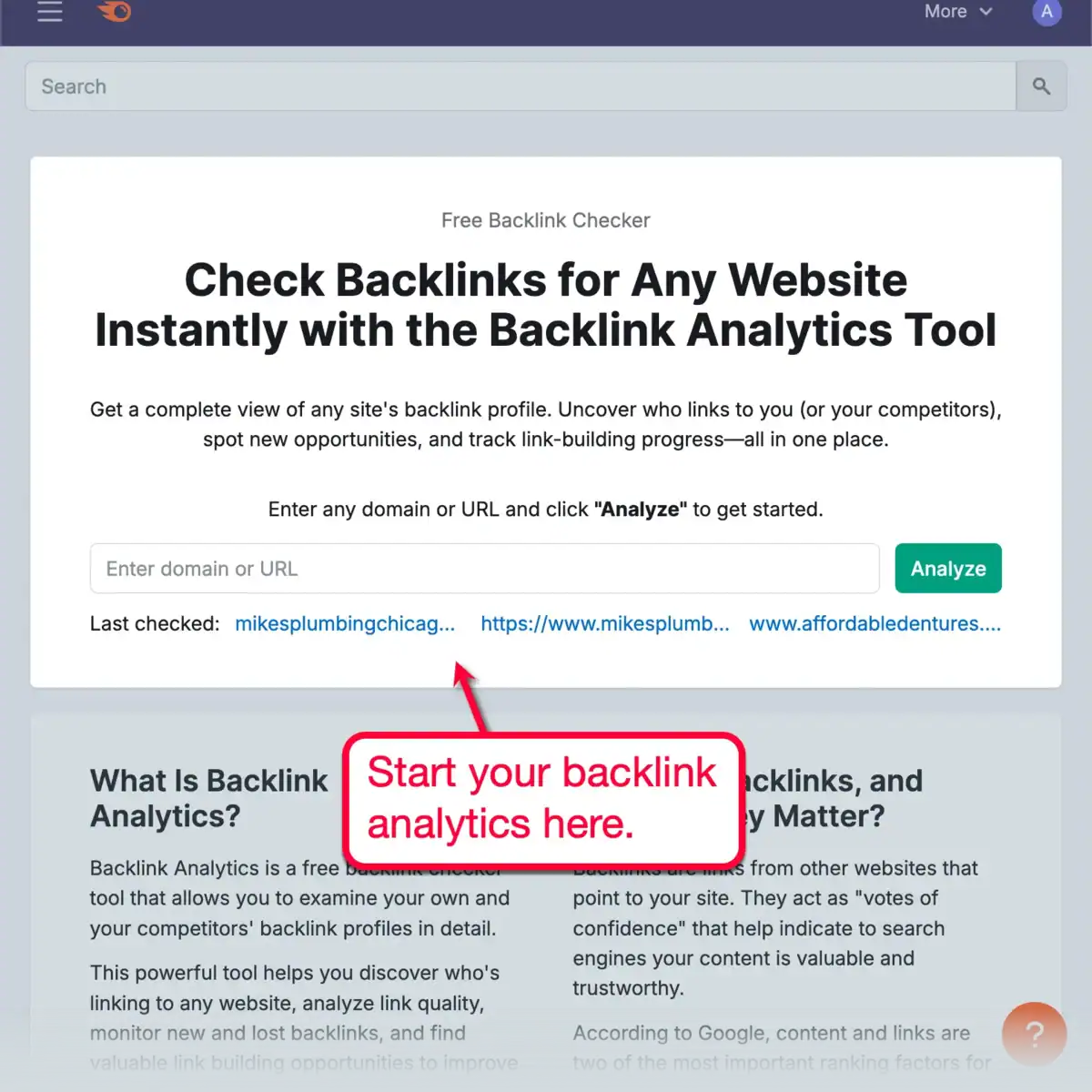
After compiling your competitor’s backlink profile data, switch to the ‘Anchors’ tab. This will help you uncover some of the keywords they’re actively optimizing for (regardless of whether they rank well for them or not).

Just remember that you’ll also find a lot of unoptimized anchor texts — often the result of natural links.
What you want are the obvious keywords that your competitor can squeeze business value out of.
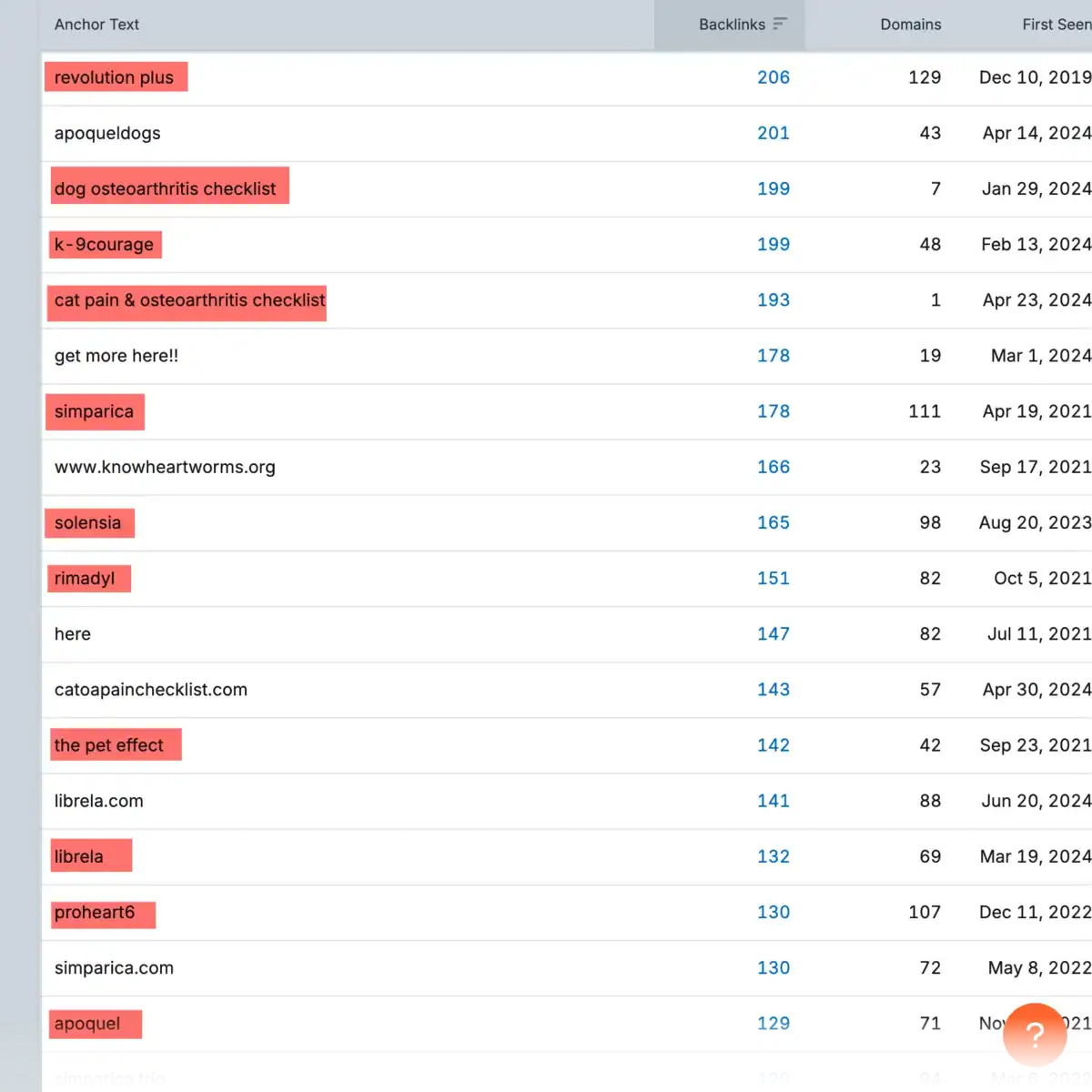
5. Identifying Keyword Gaps
Keyword gap analysis is an excellent strategy that lets you find juicy keyword opportunities by comparing your website to that of multiple competitors — all at once.
I’ve personally used Semrush to identify keyword gaps between my blog and my toughest competitors. By understanding the weaknesses (and strengths) of my keyword strategy, I was able to keep up with the tough content marketing space and stay relevant despite not having a full-on agency to back me up.
From the Semrush main menu, go ahead and click ‘Keyword Gap’ under “Competitive Research.”
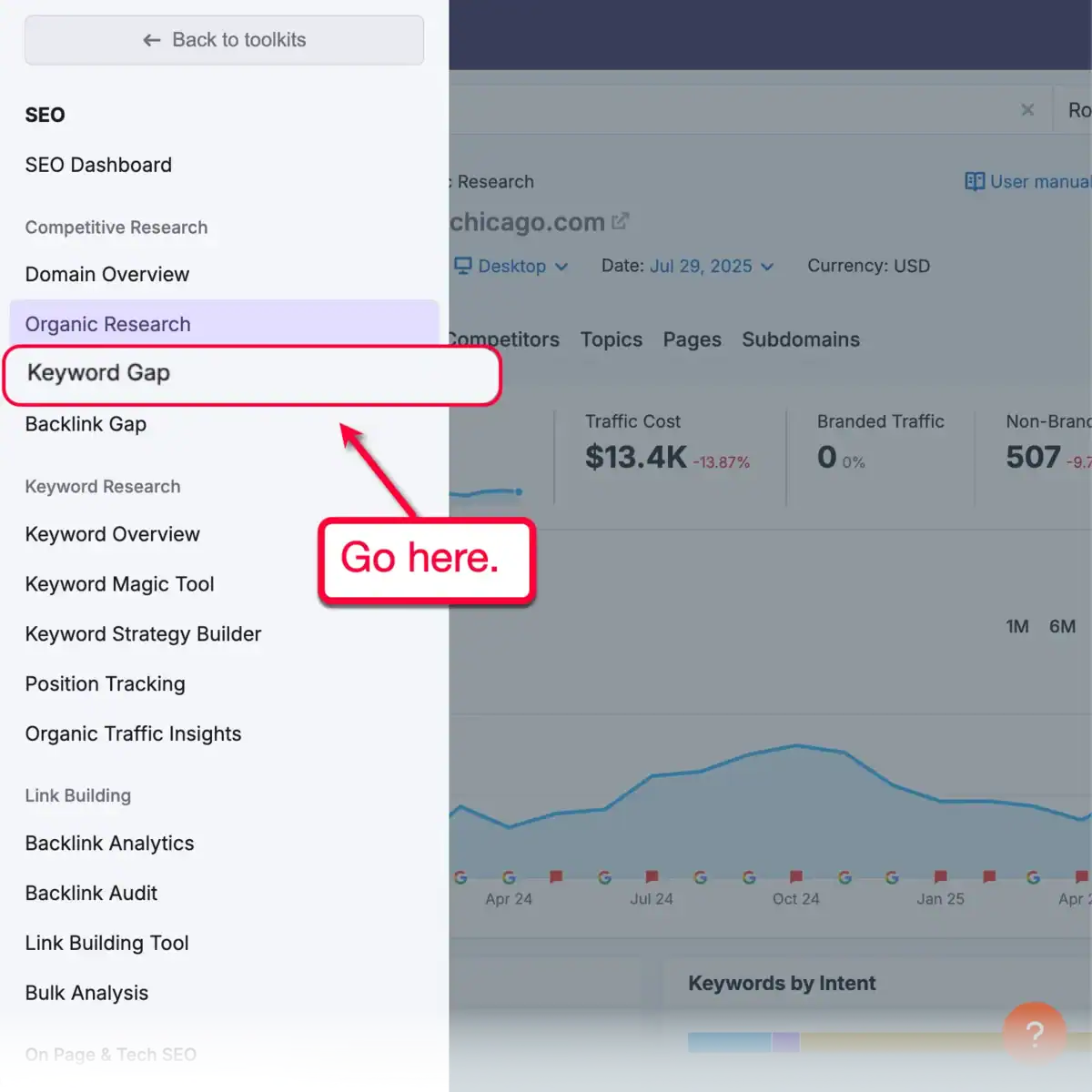
On the keyword gap analysis page, enter your own website as the first domain — then fill in the rest with your competitors’ URLs. Up to four other domains can be added for the analysis.

After clicking ‘Compare,’ Semrush will generate a detailed report that compares the keyword portfolio of all entered websites.
For example, in the “Top Opportunities” section, the ‘Missing’ tab shows keywords that your competitors rank for but not your website.
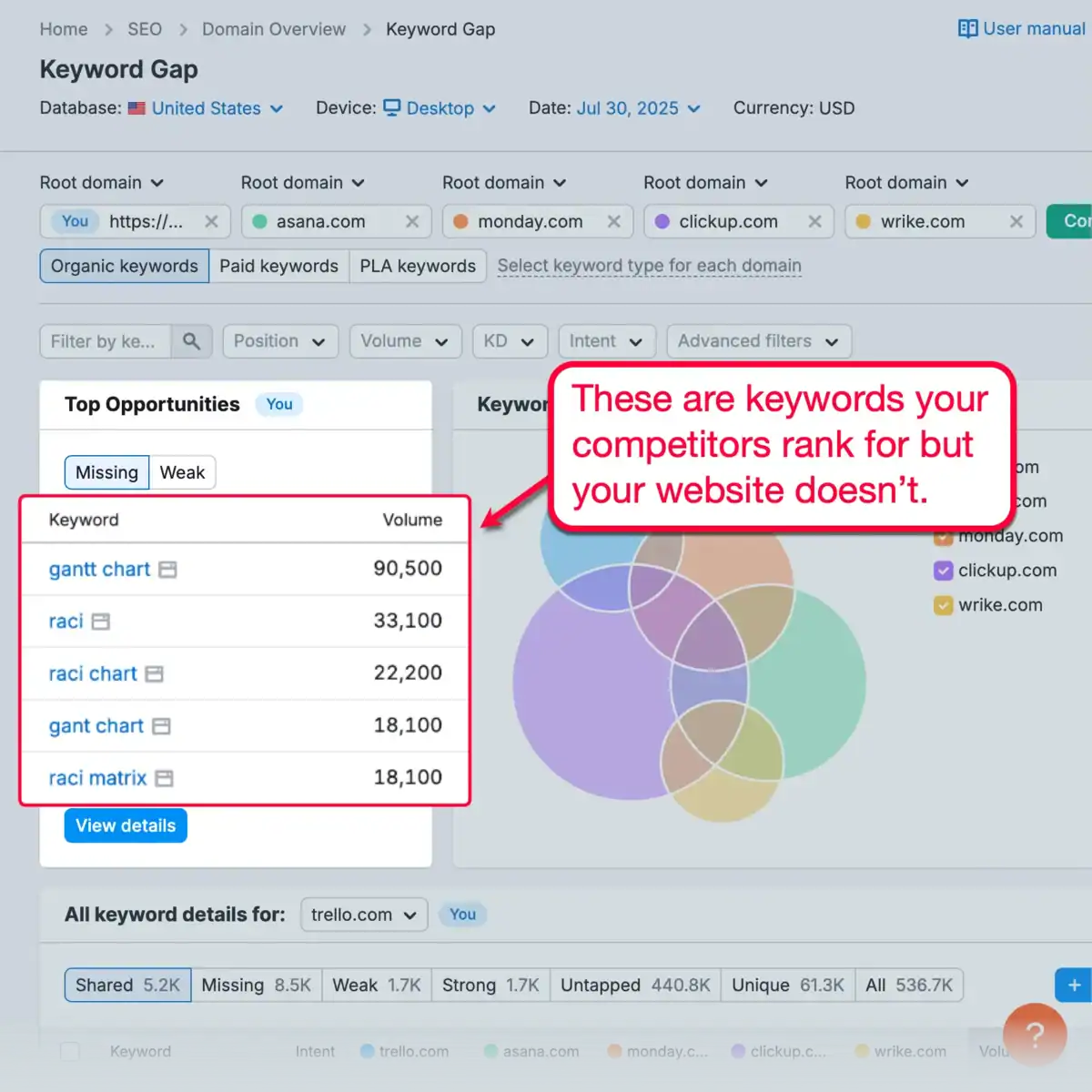
Aside from missing keywords, there are five other keyword categories revealed by the Keyword Gap tool:
- Shared Keywords — Keywords that all entered domains (including yours) are currently ranking for.
- Weak Keywords — Keywords that you rank for, but measurably lower than your competitors.
- Strong Keywords — Keywords that you rank for better than competitors (for maintaining your advantage).
- Untapped Keywords — Missing keywords that only at least one competitor ranks for.
- Unique Keywords — Keywords that only your website ranks for.
Just switch between the tabs in the keyword list at the bottom of the report to find these keywords.
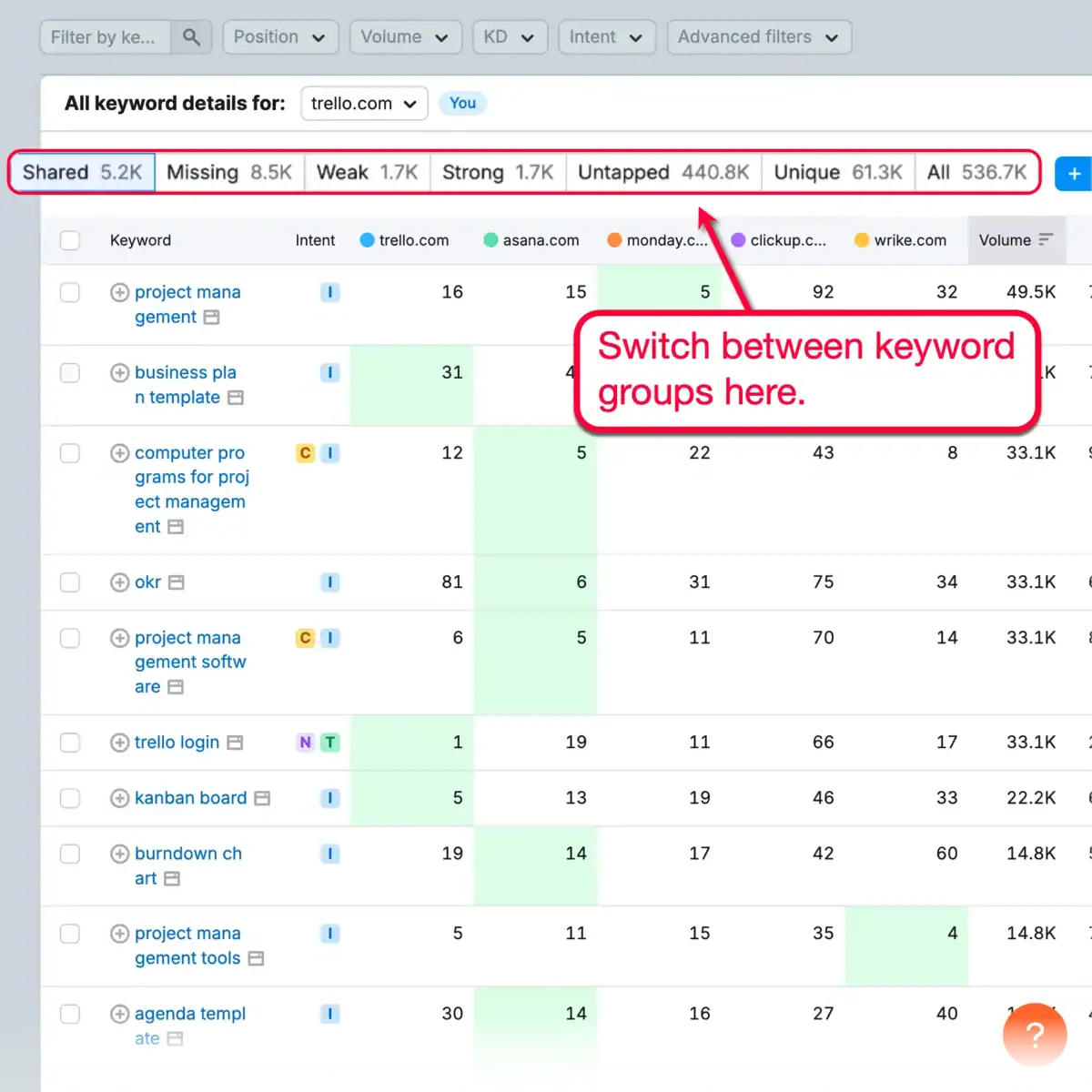
Tip: Don’t forget that you can use filters to refine the keyword gap list. Make sure you use the “exclude” filter to rule out branded keywords meant for competitors.
Bonus: Uncovering Crucial Topical Keywords
As a blogging expert by nature, I always try to view SEO keywords from a content perspective.
That means analyzing how keyword targeting translate to content strategies, like:
- Which content types best represent the keyword’s main topic?
- What kind of information do audiences expect?
- What other relevant subtopics must be included?
I can answer these questions by investigating the ‘Topics’ tab in the organic research report.
Here, I get an organized view of keywords based on my competitor’s best-performing topics.

By clicking on one of the subtopics in the group, Semrush extracts all the relevant keywords for that topic.

Remember, using Semrush to spot keywords that bigger websites already use is a cost-effective and time-saving way to get ahead of the competition. And now that you also know how competitors incorporate those keywords into their content strategy, all that’s left is to craft something that’s clearly better in terms of quality and depth.
That’s a topic for another day (tip: Semrush’s Content Toolkit is the solution for that).
Conclusion
If you’re serious about your business’s online presence, competitor keyword research with Semrush should be your first step.
Not only will you find keywords that are already proven to work, it can help you build an action plan that covers:
- Which keywords should you target first (missing keywords, competitor “lost” keywords, and purchase-intent keywords)?
- How keywords relate to content (competitor’s best-performing topics)?
- What keywords do competitors want to rank for (backlink anchor texts)?
Best of all, you’re not spending as much time, money, and energy to discover these keywords — your competitor already did it for you.
Interested in testing the strategies listed above?
Consider creating a free trial account here. Or, click here for Semrush pricing details and pick a plan that works for you!
For More Go to : Master Blogging
No comments